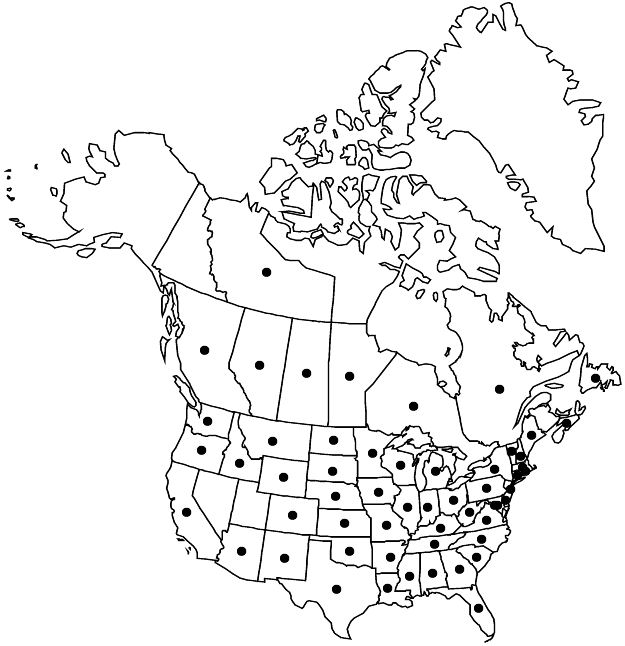Difference between revisions of "Linum usitatissimum"
Sp. Pl. 1: 277. 1753.
FNA>Volume Importer |
FNA>Volume Importer |
||
| Line 31: | Line 31: | ||
|elevation=0–2400 m. | |elevation=0–2400 m. | ||
|distribution=Alta.;B.C.;Man.;Nfld. and Labr. (Nfld.);N.W.T.;N.S.;Ont.;Que.;Sask.;Ala.;Ariz.;Ark.;Calif.;Colo.;Conn.;Del.;D.C.;Fla.;Ga.;Idaho;Ill.;Ind.;Iowa;Kans.;Ky.;La.;Maine;Md.;Mass.;Mich.;Minn.;Miss.;Mo.;Mont.;Nebr.;N.H.;N.J.;N.Mex.;N.Y.;N.C.;N.Dak.;Ohio;Okla.;Oreg.;Pa.;R.I.;S.C.;S.Dak.;Tenn.;Tex.;Vt.;Va.;Wash.;W.Va.;Wis.;Wyo.;Eurasia;introduced also in c Mexico;Central America;s South America;Pacific Islands (New Zealand). | |distribution=Alta.;B.C.;Man.;Nfld. and Labr. (Nfld.);N.W.T.;N.S.;Ont.;Que.;Sask.;Ala.;Ariz.;Ark.;Calif.;Colo.;Conn.;Del.;D.C.;Fla.;Ga.;Idaho;Ill.;Ind.;Iowa;Kans.;Ky.;La.;Maine;Md.;Mass.;Mich.;Minn.;Miss.;Mo.;Mont.;Nebr.;N.H.;N.J.;N.Mex.;N.Y.;N.C.;N.Dak.;Ohio;Okla.;Oreg.;Pa.;R.I.;S.C.;S.Dak.;Tenn.;Tex.;Vt.;Va.;Wash.;W.Va.;Wis.;Wyo.;Eurasia;introduced also in c Mexico;Central America;s South America;Pacific Islands (New Zealand). | ||
| − | |discussion=<p>Linum usitatissimum has been cultivated since antiquity, and it is this cultivated form that has naturalized in the wild. Flax fibers twisted to make rope or dyed for fabric dated 32,000–26,000 years before present were found in a cave in Dzudzuana, Georgia (E. Kvavadze et al. 2009). Stem fibers of L. usitatissimum are used to make linen; the seeds are pressed to produce linseed oil; the rest of the seeds are compacted into cakes and used as fodder. Linum usitatissimum is the only species in the flora area except L. bienne that has linear stigmas and minutely ciliate inner sepals. It can be distinguished from L. bienne by its larger, apically rounded capsules.</p> | + | |discussion=<p><i>Linum usitatissimum</i> has been cultivated since antiquity, and it is this cultivated form that has naturalized in the wild. Flax fibers twisted to make rope or dyed for fabric dated 32,000–26,000 years before present were found in a cave in Dzudzuana, Georgia (E. Kvavadze et al. 2009). Stem fibers of <i>L. usitatissimum</i> are used to make linen; the seeds are pressed to produce linseed oil; the rest of the seeds are compacted into cakes and used as fodder. <i>Linum usitatissimum</i> is the only species in the flora area except <i>L. bienne</i> that has linear stigmas and minutely ciliate inner sepals. It can be distinguished from <i>L. bienne</i> by its larger, apically rounded capsules.</p> |
|tables= | |tables= | ||
|references= | |references= | ||
| Line 56: | Line 56: | ||
|publication year=1753 | |publication year=1753 | ||
|special status=Weedy;Introduced | |special status=Weedy;Introduced | ||
| − | |source xml=https://jpend@bitbucket.org/aafc-mbb/fna-data-curation.git/src/ | + | |source xml=https://jpend@bitbucket.org/aafc-mbb/fna-data-curation.git/src/8f726806613d60c220dc4493de13607dd3150896/coarse_grained_fna_xml/V12/V12_334.xml |
|genus=Linum | |genus=Linum | ||
|section=Linum sect. Linum | |section=Linum sect. Linum | ||
Revision as of 14:45, 18 September 2019
Herbs, annual, 20–100 cm, glabrous or glabrate throughout. Stems erect, unbranched or few-branched at base (all flowering). Leaves divergent; blade linear to linear-lanceolate, 10–40 × 1.5–5 mm. Inflorescences open panicles. Pedicels erect in fruit, to 20–25 mm. Flowers homostylous; sepals ovate, 6–9 mm, margins of inner sepals minutely ciliate, outer ciliate, apex acuminate; petals usually blue, rarely white, obovate, 10–15 mm; stamens 5–7 mm; anthers 1–1.5 mm; staminodia present; styles distinct or connate at base, 3–6 mm; stigmas linear or clavate. Capsules ovoid to subglobose, 6–10 × 5–10 mm, apex rounded, dehiscing incompletely, segments falling freely, margins ciliate or not. Seeds 4–6 × 2.5–3 mm. 2n = 30.
Phenology: Flowering Apr–Sep.
Habitat: Disturbed areas, roadsides, abandoned homesteads, fields.
Elevation: 0–2400 m.
Distribution

Alta., B.C., Man., Nfld. and Labr. (Nfld.), N.W.T., N.S., Ont., Que., Sask., Ala., Ariz., Ark., Calif., Colo., Conn., Del., D.C., Fla., Ga., Idaho, Ill., Ind., Iowa, Kans., Ky., La., Maine, Md., Mass., Mich., Minn., Miss., Mo., Mont., Nebr., N.H., N.J., N.Mex., N.Y., N.C., N.Dak., Ohio, Okla., Oreg., Pa., R.I., S.C., S.Dak., Tenn., Tex., Vt., Va., Wash., W.Va., Wis., Wyo., Eurasia, introduced also in c Mexico, Central America, s South America, Pacific Islands (New Zealand).
Discussion
Linum usitatissimum has been cultivated since antiquity, and it is this cultivated form that has naturalized in the wild. Flax fibers twisted to make rope or dyed for fabric dated 32,000–26,000 years before present were found in a cave in Dzudzuana, Georgia (E. Kvavadze et al. 2009). Stem fibers of L. usitatissimum are used to make linen; the seeds are pressed to produce linseed oil; the rest of the seeds are compacted into cakes and used as fodder. Linum usitatissimum is the only species in the flora area except L. bienne that has linear stigmas and minutely ciliate inner sepals. It can be distinguished from L. bienne by its larger, apically rounded capsules.
Selected References
None.